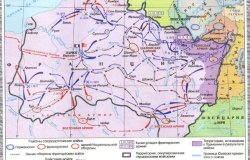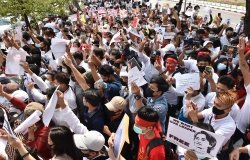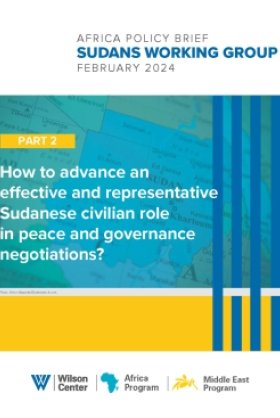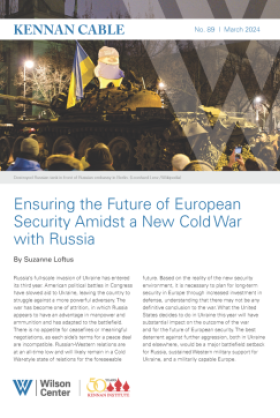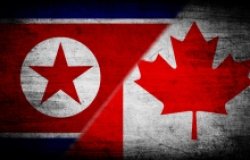4 Reasons Elections Won't Fix Afghanistan
No matter how free, fair, credible, and legitimate the election ultimately is (or is not), Afghanistan has a long way to go before it becomes a more stable state. Here are four reasons why.
Observers across the board—from think-tankers and diplomats (both current and retired) to journalists and election monitors—are describing Afghanistan’s April 5 election as critical for stability.
And for good reason. A successful election would be a democratic milestone, as it would mark the first time Afghanistan has experienced a peaceful transfer of power. A legitimately elected new leadership, particularly one seen as effective and above all clean, could conceivably help convince Afghans that their government is a better alternative to the Taliban—and thereby weaken recruitment to the insurgency.
It would also bring to power a leader not named Hamid Karzai—and therefore someone who would likely sign a bilateral security agreement with Washington, ensuring that a residual international military presence remains in Afghanistan after this year.
And yet a successful election is far from assured. On March 10, the Taliban promised “to use all force” at its disposal “to disrupt these upcoming sham elections.” Supporters of the top two candidates—Ashraf Ghani and Abdullah Abdullah—have been targeted. Recent days have brought attacks on two different Afghan election commission facilities. Turnout could be compromised in a big way—though to their credit, many Afghans vow to defy the Taliban and vote anyway.
Equally troubling is the growing potential for fraud and other electoral illegalities—especially after a March 21 deadly assault on Kabul’s Serena Hotel prompted many international election monitors to leave Afghanistan. Last week, Afghan election officers accused government employees of using state resources to help the campaign of Zalmai Rassoul—the man thought to be Karzai’s preferred candidate. There’s even been speculation that Karzai could postpone the election in order to pursue a peace deal with the Taliban.
This is all quite unsettling. Yet here’s an even more sobering thought: Even if none of these things were happening, there would still be reason to worry. And that’s because no matter how free, fair, credible, and legitimate the election ultimately is (or is not), Afghanistan has a long way to go before it becomes a more stable state.
Here are four reasons why.
1. Afghan military forces continue to be a work in progress.
Pointing to decreased levels of violence in numerous areas controlled by Afghans, optimistic observers insist that Afghan security personnel “are doing better than almost anyone expected.” Still, their capacities remain limited. In Congressional testimony in February, top Pentagon officials conceded that while Afghan troops are earning tactical victories on the battlefield, they struggle to hold cleared territory and still need much help in areas like transport and intelligence.
And then there’s the question of basic preparedness. In 2012, half of Afghanistan’s army was estimated to be addicted to drugs, and last year 65 employees with the main spy agency were fired due to opium addictions. Additionally, a staggering 95 percent of military and police recruits have been described as functionally illiterate. An investigation released in January by the U.S. Special Inspector General for Afghanistan Reconstruction concluded that despite a $200 million U.S.-funded literacy program, half of Afghanistan’s military and police force will probably remain illiterate until decade’s end. Finally, perhaps most disturbingly, the Afghan army suffers from a 33 percent annual attrition rate. According to U.S. Director of National Intelligence James Clapper, 30,000 soldiers deserted in 2013—out of a total force of 185,000.
None of this inspires much hope that the Afghan military will be able to tame the Taliban insurgency—one that an international mission comprising some of the most powerful militaries in the world hasn’t defeated after nearly 13 years of trying.
2. Taliban sanctuaries in Pakistan are still open for business.
The insurgency in Afghanistan is sustained by the haven its fighters—led by the Afghan Taliban and the Haqqani network—enjoy in Pakistan’s North Waziristan tribal agency. For years, Washington has pushed Pakistan to smash these sanctuaries to no avail. Finally, earlier this year, Islamabad suggested that an operation was imminent—though the government made it clear that only “anti-state” militants (those that attack Pakistan), such as the Pakistani Taliban (TTP), would be targeted. However, with a peace process now underway between Islamabad and the TTP, any operation appears to have been delayed indefinitely.
Pakistan provides the sanctuaries because it regards the Afghan Taliban and Haqqani network as strategic assets that help contain Indian influence in Afghanistan. Unless Islamabad’s relations are miraculously normalized with New Delhi, this Pakistani objective is unlikely to change—particularly with India having tightened its ties with Kabul in recent years, including a strategic partnership agreement that calls for training and other non-combat support for the Afghan military.
Additionally, by eliminating the sanctuaries, Pakistan would also eliminate a key source of leverage over the Afghan Taliban—and give the group an opportunity to turn against its sponsor. Given the hostility evinced by many Afghan Taliban members toward the Pakistani security establishment—they’ve voiced their mistrust of Pakistan’s spy agency and chafed at being dependent on it—this is by no means an unlikely scenario. The usefulness of Pakistan for the Afghan Taliban would also decline if the security vacuum in Afghanistan left by the international troop departure allows the Taliban to re-establish havens in Afghanistan, rendering those in Pakistan superfluous. In effect, Taliban sanctuaries will likely remain in Pakistan unless they are reestablished in Afghanistan. Neither scenario bodes well for Afghanistan’s stability.
3. Afghanistan remains a magnet for regional militants.
Much has been said about how the withdrawal of international troops from Afghanistan is prompting anti-India extremist organizations active in that country in recent years (such as Lashkar-e-Taiba) to redirect their attention to India. Yet for now, and in all likelihood for the foreseeable future, militants are continuing to pour into Afghanistan. Afghan officials and Taliban commanders claim that since announcing a ceasefire with Islamabad on March 1, the Pakistani Taliban—already very active in Afghanistan—has been deploying fighters into the country. Meanwhile, Pakistani researchers estimate that “hundreds” of militants from Pakistan’s Punjab province—ranging from sectarian extremists to anti-India jihadists—have relocated to the tribal areas in preparation for assaults on Afghanistan. And Indian security officials assert that their chief indigenous Islamist militant threat, the Indian Mujahideen, “has branched out” to Afghanistan to fight alongside the Afghan Taliban.
Meanwhile, Central Asian extremists have their eyes on northern Afghanistan. The Islamic Movement of Uzbekistan (IMU) is attempting to establish a base in the city of Kunduz. And according to journalist Ahmed Rashid (who has written extensively on Central Asian militancy), the IMU, in concert with Pakistani and Afghan militants, may be trying to secure Afghanistan’s entire northeastern corridor in order to establish a base for operations against Kabul. With Moscow ramping up its presence in Afghanistan through a series of development projects, Central Asian militants—most of whom dislike both Kabul and Moscow—have strong incentives to intensify their operations in Afghanistan.
4. The Taliban and its allies aren’t Afghanistan’s only destabilizing forces.
With so much emphasis on the violence perpetrated by the Afghan Taliban and its allies, it’s easy to forget that groups opposed to the Taliban insurgency fuel instability as well. In many areas of Afghanistan, particularly in the north and west where the Taliban’s presence is lighter, militia commanders (many of them U.S.-funded) have terrorized local populations. Not only do they assault and kill people, but they also make life miserable for locals in more subtle ways—forcing young men to help them fight the Taliban, seizing land, and stealing irrigation water.
The kicker? Some of them are contesting the election. Six of the 11 presidential candidates—including the two favorites (Ghani and Abdullah)—have a warlord on their ticket (Abdul Rashid Dostum and Mohammad Khan, respectively).
Some may argue that participating in the political process suggests peaceful intentions. However, early signs aren’t encouraging. In recent weeks, supporters of Ismail Khan, another warlord (running on the ticket of Abdul Rassoul Sayyaf) clashed with Abdullah’s supporters, leading to several deaths.
***
None of this is meant to suggest that Afghanistan’s election is irrelevant for stability. A successful poll alone won’t make Afghanistan more secure, but it can potentially produce what is arguably the sine qua non for future stability: Strong leadership.
This means incorruptibility and an ability to deliver basic services and dispense fair justice. It also means an unwavering commitment to building Afghanistan’s military (and police) into a more sustainable force—one that can both perform basic functions and tame insurgencies (admittedly, it’s a task that will require much international support). Finally, strong leadership means the pursuit of delicate diplomacy: Maintaining partnerships with foreign donors and allies, hashing out differences with difficult neighborhood interlocutors (most notably Islamabad), and—most critically—reconciling its many feuding factions (including, ultimately, the Taliban) at home.
The problem, however, is that strong leadership could prove to be as elusive as stability itself.
About the Author


Indo-Pacific Program
The Indo-Pacific Program promotes policy debate and intellectual discussions on US interests in the Asia-Pacific as well as political, economic, security, and social issues relating to the world’s most populous and economically dynamic region. Read more

